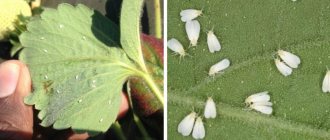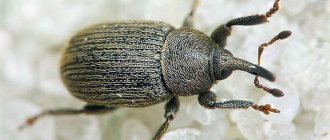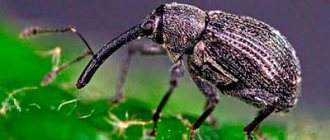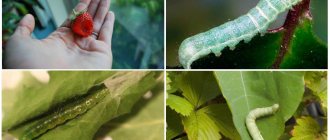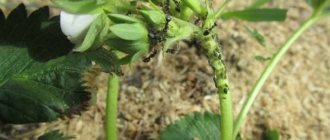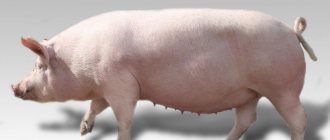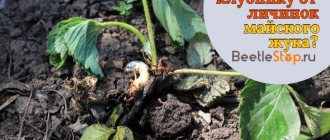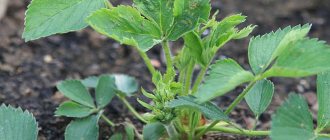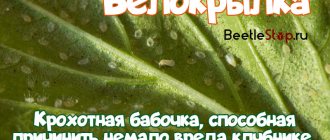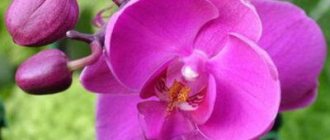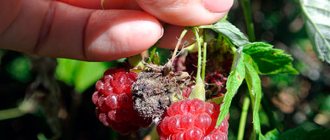A foamy lump, shaped like spittle, can most likely be found on the plot, in the garden area or in the meadows. Oddly enough, this is a nest where the larvae of the slobbering pennix develop.
Such a cocoon has a structure due to which the insect is protected from threatening factors.
The survival rate is at such a high level that this species was able to seriously spread and take first place among other parasitic species in this indicator.
One of the main targets on the site is strawberries. If this parasite is found, it must be eliminated as quickly as possible, otherwise there will be a serious risk to the plants.
What does the slobbering cicada look like?
The official name of the cicada is the common slobber or common slobber. People also call this winged insect a slobber.
The butterfly has light yellow wings with white spots. She lays eggs in the petioles of bushes. The larvae are enveloped in foamy liquid.
The body of an adult representative of the species is stocky and flattened, the length does not exceed 6 mm. A characteristic feature of strawberry pennies is their variety of colors; more than 20 variants are known. The most common colors are brown, olive and yellowish. Green, red and brown individuals are also found; each has a bandage on its body. The pattern may consist of geometric shapes, stripes and spots.
The head is quite large in size relative to the body, the frontal plate is triangular in shape, and the crown is rounded. Consumes food through the proboscis. Mouthparts are sucking type. The pronotum is wide and long, towards the end it begins to diverge to the sides. The abdomen is completely closed thanks to leathery elytra that fold into the shape of a house. The wings and upper body are covered with sparse hair. The insect jumps well. Spines and bristles form on the limbs.
The common pennitsa lives in most countries of Europe, Russia, Asia, Japan and North Africa. The species was brought to us from Canada and the USA.
The insect can run and fly, but when it feels threatened, it makes a powerful jump.
Insects feed on plant juices; a special secretion is secreted from their abdomen, the composition of which is enriched with mucins. These are polysaccharides - the main components of salivary secretion. Thanks to it, the substance is viscous and elastic. There are also small spiracles on the abdomen, which at the right moment squeeze out air, forming a lump of numerous sticky bubbles; this is mucus in the form of foam on strawberries. As necessary, this foamy layer is replenished and performs several vital functions for the larvae:
- The moist cover prevents the offspring from drying out on sunny days.
- When processing strawberries and other berries, the effects of chemicals become more difficult.
- Insects easily tolerate low and high temperatures.
The larva develops in 50 days, during which time it is constantly in the foam nest.
Symptoms of damage:
- leaves wrinkle and wither;
- the ovaries are deformed.
They fight pennies by spraying strawberries with a solution of laundry soap.
Strawberry leaf beetle
This pest damages not only strawberries, but also some wild herbs. The length of the beetles reaches 4 mm. They are yellow-brown, with a dark spot in the middle of the pronotum. Their larvae are yellow, with a dark brown head and dark spots on the back. The length of the larvae can be up to 5 mm.
At the end of the season, the beetles hibernate under plant debris. As soon as the leaves on the strawberry bushes begin to grow in the spring, the beetles come out of their shelters and begin to eat away the pulp of the leaves in the form of winding passages. The lower skin of the leaf remains intact. Sometimes beetles gnaw through holes.
Just before strawberries bloom, females lay eggs on the underside of the leaves, but petioles and stems can also be a laying site.
After a couple of weeks, larvae appear and eat the pulp of the leaves with small windows, leaving the upper skin intact. After three weeks they finish developing and go into the soil. Larvae pupate in the soil. At a depth of one to three centimeters, close to bushes.
Strawberry fruiting is ending. And just then young beetles appear. They first feed on leaves and then go to winter. The strawberry leaf beetle develops in one generation. If there are a lot of beetles, the leaves dry out. But the berries do not develop.
How to fight
- Destroy all weeds.
- In the spring, you can spray with commercially available preparations. But everything must be done strictly according to the instructions.
- At the end of fruiting, you need to thoroughly loosen the soil under the bushes.
To be continued.
When preparing the text, information was used from the book “Protection of Plants in the Garden.”
Website www.lubludachu.ru
How to deal with drool on strawberries
Basic methods of fighting cicadas:
- Remove the affected fragments of the bush, the amount of organic and mineral fertilizing should be reduced.
- It is effective to use predators in the fight, for example, ladybugs and lacewings.
- An infusion of tansy, tobacco, wormwood or petunia with shavings of laundry soap is effective. It is necessary to carefully process the leaf blades on the underside, as well as the soil near the trunk and the area where the roots are approximately located.
- If cicadas have attacked strawberry varieties growing at home, it is necessary to place plants with strong odors nearby. The most effective are lovage, lemon balm, lavender and thyme.
- For pennies, it is effective to use chemical insecticidal aerosols. Based on reviews from agronomists, the most effective drugs are Bona Forte brand products and Permethrin aerosol.
- In non-residential premises, you can use a solution from a Dutch manufacturer called Fufanon-Nova, which is an alternative to Actelik.
- To irrigate bushes, you can use the Hungarian chemical preparation of contact-intestinal action - Kinmiks.
In the fight against cicadas, adherence to agrotechnical practices is no less effective. When getting rid of insects, it is worth using an integrated approach: chemical, folk and biological preparations.
Chemical treatment
To effectively combat slobber, chemicals are often used. This is due to the fact that the insect is quite resistant to aggressive environmental factors. However, manufacturers annually release substances that will provide the desired and sustainable result.
- Karbofos is sold in two forms: liquid and powder. It is enough to dilute in water and irrigate the affected strawberry bushes with the resulting solution.
- Fluffy lime or the usual slaked lime. Sold in large volumes. For 30 kg of product you will need to pay no more than 300 rubles. The powder must be scattered in damaged areas after the main treatment with chemicals. It is also recommended to carefully cultivate the soil among the bushes.
- Commander is a liquid designed to combat the Colorado potato beetle, but it has also been shown to be effective against the pennies. The cost of 30 ml is approximately 100 rubles.
To prevent re-infestation by pentilica, the crop should be treated with wood ash. This procedure must be carried out only after harvesting.
It is prohibited to irrigate crops with chemicals during the growing season.
Folk remedies for drooling pennies
There are many folk recipes that can effectively fight various types of cicadas, including pennies.
The main ones:
- Garlic infusion. 1 cup of chopped garlic cloves must be poured with 10 liters of water. During the day, the infusion should be infused in a dark, cool place. The resulting composition is used to carefully treat the affected areas.
- Mustard solution. To prepare the solution you will need 50 g of dry mustard and 5 liters of water, mix the components thoroughly and pour them over the diseased bushes.
- Laundry soap solution. You need to add shavings of laundry soap to several liters of clean water. The solution should be concentrated and cloudy in color. Not only the bush is irrigated with the resulting composition, but the pennies themselves are also additionally processed.
How to fight mechanically
The simplest and yet most effective method of control is to collect the larvae of pennies by hand. You can do this with gloves and plastic bags on your hands.
Another effective method, but at the same time traumatic for the plant, is treatment with a powerful stream of water. The cicadas will die under water pressure.
Pest control methods
The slobbering pennitsa has no taste preferences; it feeds on grains, flowers, vegetables, strawberries, currants, grapes and fruit trees. In total, there are about 170 plants that are damaged by the phytophage. As a result of damage to leaves and stems, places for various viruses and diseases to penetrate. Pennywort is a carrier of the jaundice virus, which infects peach. As a result of the sap being sucked out by a large colony of pests, the plant lags behind in development, the leaves curl, the ovaries develop poorly, and the vegetative organs are deformed. How to deal with the slobbering pennitsa?
There are several methods to quickly and safely destroy the pest.
Chemical
If there is a large accumulation of insects, insecticides cannot be avoided; for the treatment of infected crops, it is recommended: Aktara, Karbofos, Intavir, Kinmiks. The drugs are diluted according to the instructions and sprayed in the morning.
Folk remedies
To maintain the purity of vegetables and fruits, you can destroy pests using natural means. An effective measure to combat foamy bib is to use a solution of laundry soap (200 g of product per 10 liters of water). Infusions of tansy and wormwood help against the pest (pour 0.5 kg of herb into 10 liters of boiling water, leave for 3-4 hours). A good result is obtained by treating with garlic infusion - 1 glass per bucket of water, leave for 1-1.5 hours.
Advice. You can sprinkle wood ash directly onto the foam lumps. This is detrimental to the larvae.
The pest often settles on strawberries so as not to spoil the crop with chemicals; foam nests are easily washed off with water, and insects are collected by hand.
Preventive actions
It is always easier to prevent the appearance of insects than to get rid of them. It is necessary to regularly inspect plants for the presence of insects. To prevent the formation of foam on strawberry leaves, it is necessary to follow not only all the rules of care, but also promptly treat the crops with special preparations.
Effective preventive manipulations for the appearance of pennies:
- Treat the soil with steam, using semi-steam treatment effectively.
- Weed control and timely removal.
- To prevent foam from forming on strawberry bushes, when planting, you should maintain an interval between seedlings. Among dense plantings, the probability of damage increases significantly.
- Damaged, dried parts of the plant should be regularly removed and destroyed.
Having figured out what kind of drool is on strawberries, you need to act immediately. It is better to prevent pests from appearing than to fight them later. To prevent the appearance of pennies, it is recommended:
- remove weeds in a timely manner;
- do not plant densely;
- apply semi-fallow tillage.
Good care will ensure the health of the plants, which means they will not be afraid of enemies.
It is best to prevent a problem rather than fight it after the fact. Prevention is one of the main measures to combat slobbering pennies.
To prevent damage to your plants, it is important to both comply with care standards and timely treatment of strawberries using special products.
Through numerous trials, the following effective tips were derived:
- when weeds appear, they must be removed in a timely manner;
- pruning dried and damaged areas of plants;
- soil treatment using the semi-steam method;
- Maintaining a sufficient distance between bushes helps prevent the formation of foam on the foliage. A dense bed has a much greater chance of developing parasites, as well as various diseases.
Chemical based products
Proper use of chemicals greatly increases the chances of success. These remedies are among the most effective because parasites show good resistance to external factors.
The development of drugs takes into account this feature of insects.
Current use:
- Commander: First of all, the purpose of the drug is to combat Colorado potato beetles, but good results are also observed for the pennies. You can buy it in liquid form.
- Karbofos: can be either in liquid or powder form. To treat affected areas, it is necessary to dilute the composition with water.
- Slaked lime or fluffed lime: can be purchased in large quantities, usually 30 kg. Upon completion of chemical treatment, this powder is scattered on the affected area.
Wood ash acts as a preventative measure. It is used exclusively after picking berries.
The use of chemicals is strictly not recommended during the growing season.
Folk remedies
Among the large number of folk remedies, the most often used are:
- mustard in the form of a solution: 50 g of product per 5 liters. water, requires thorough mixing and application to the bush by irrigation;
- Laundry soap is also used in the form of a solution.
First you need to make shavings, which are mixed with 2-3 liters. water. The final form should be a cloudy and concentrated liquid. It, like the previous remedy, is used to irrigate the bushes. But you can additionally process pennitsa.
Garlic infusion: chop the cloves and collect them in a glass. The cloves are filled with water in a volume of 10 liters.
The infusion should stand for a day; it is advisable to choose a cool and dark place. Apply the product to the affected area.
Prevention
Since the leafhopper overwinters in eggs that are attached to plants, destroying all weeds in the fall will help significantly reduce the number of pests. It is useful to wash the trunks and branches of trees and shrubs in the fall with brushes and soapy water, and after drying, whitewash them with lime.
The pest loves dense thickets and humidity. If the watering regime is followed and the plants are planted spaciously, the slobber will be uncomfortable.
Many gardeners practice planting herbs in their gardens and gardens, whose aroma repels pests. These are lavender, lemon balm, thyme.
Ladybugs are natural predators of leafhopper larvae.
https://moj-zvetnik.ru/slyunyavaya-pennica-na-klubnike/https://dizajn-sada.ru/uxod-za-sadom/borba-s-vreditelyami/slyunyavyj-vreditel-pennica/https:// 3vedra.com/vrediteli/pennica-slyunyavaya.html
What plants suffer from drool?
In our country, the harmful effects of pennies can be seen on grapes, strawberries, currants, raspberries, fruit trees, potatoes, sugar beets, tobacco, cabbage, dahlias, roses, chrysanthemums and many other plants. There are isolated cases of foam appearing on tomatoes, but this is the exception rather than the rule - Slyunyavka does not like tomatoes.
These leafhoppers feed on plant sap, piercing their delicate tissues. The result of this action is wrinkling of the leaves, underdevelopment of the ovaries, deformation of the generative and vegetative organs. In the southern regions, this pest carries the peach jaundice virus.
Distribution of phytophage
The common slug is found in most European countries, Russia, Asia, Japan, and North Africa. The species was introduced to North America and Canada and took root well there. Insects are found in regions with a harsh climate - Murmansk, Khabarovsk, Dudinka, Kamchatka, Primorye.
Penny can fly and run, but in case of danger she makes a powerful jump.
Philaenus spumarius
Common froghopper, Philaenus leucophthalmus, Spittlebug, Common froghopper, Meadow froghopper,
The slobbering frog is a polyphagous pest, especially dangerous in North America, where it is a carrier of peach gomosis. In Azerbaijan it damages grain crops, in Georgia - fruit trees, in the Ciscaucasia - lavender, in Ukraine - tobacco, in Russia - various vegetables, in England - potatoes, in Turkey - sugar beets. It is noted as a pest of grapes, strawberries, currants, fruit trees, dahlias and many other plants. Development is incomplete. Reproduction is bisexual. One generation develops per year. The egg overwinters.
Click on photo to enlarge
Morphology
Imago. A stocky planthopper of medium size, 5–6 mm long. The top is covered with sparse hair. The color is variable: from pale brown to black, sometimes gray, reddish or greenish. There may be light bands or longitudinal stripes on the body.
The vertex in the anterior part is obtusely rounded, at the apex there is a triangular-shaped frontal plate.
The pronotum is longer and wider than the head, the lateral margins slightly diverge to the sides.
The scutellum is small, shorter and narrower than the pronotum.
The elytra are dense, leathery, and completely cover the abdomen.
The tibiae are round in cross-section, with two teeth on the outer edge and a double rim of spines at the apex below.
Sexual dimorphism. Individuals of different sexes differ in the structure of their genitalia.
Secondary sexual characteristics:
Male. Anal tube with ventrolateral teeth. The pygophorus on the posterior lateral margin has no teeth.
Egg. Small. The eggs are arranged in groups of 30, covered with the female's secretions.
Description of the insect
The leafhopper is an insect from the order Homoptera, widespread in Europe, Asia, North America and Africa. Sometimes the pest is found in the harsh climate of the northern regions. The pennywort settles on wild and cultivated plants.
The insect is a jumping moth with triangular wings, similar in appearance to a moth butterfly. The body length of an adult is 5–8 mm. The color is gray, brown or olive. The wings, covered with fine fluff, are folded into a small house. The insect's head is large and equipped with a proboscis for feeding. The butterfly can fly and run. In case of danger, jumps to a height of up to 70 cm.
Once a year, each female lays up to 40 eggs, from which larvae 3–4 mm long hatch. This butterfly does not have a pupa development stage. Larval caterpillars begin to suck juices from plant stems immediately after emerging from the eggs. Their habitat is covered with thick white foam. This kind of cocoon serves as protection for young insects from the external environment, predators and poisons.
Each larva turns into a butterfly by autumn. Females lay eggs, which survive the winter in plant debris and hatch when the weather warms in April-May. The insect completes its development in 30–40 days.
Green leafhopper
The green leafhopper parasitizes a large number of plants, from cereals to berry bushes, apple trees, pears, plums and other fruit trees. Interestingly, the green leafhopper prefers young plants and is rarely found in older gardens. This is all because it prefers to damage the thin bark. Like all leafhoppers, it loves damp places. Most common habitats:
- damp areas;
- thickets;
- unthinned plantings.
The butterfly has a size of 5.5-9 mm. It is green in color with a yellow head and black dots on the crown. The larvae hatch from eggs laid in the fall in April-May and develop into adults by August. Cicada eggs prefer to be laid closer to the base of the trunk. In the process of laying eggs, the female cuts the bark and lays eggs in wounds up to 5 mm long. Each individual inflicts 10-11 such damage. This may indicate the scale of damage they cause to garden plants.
Insect harm
The leafhopper lays eggs in the fall in the bark of young branches and trunks. It is most dangerous for young trees 2-3 years old. In trees older than 5 years, damage heals quickly, leaving a slight mark, and young plants begin to lag in growth and die as a result of disruption of sap flow at the site of egg laying.
Green leafhopper is a carrier of cytosporosis
This type of leafhopper is a carrier of cytosporosis. The spread of cytosporosis can lead to the complete destruction of the garden.
Control measures
It is necessary to constantly weed the garden so that there are no thickets of weeds, where a moist environment is formed, which is preferable for leafhoppers. It is also necessary to remove damaged branches and excess growth.
Trees must be periodically sprayed with organophosphates and pyrethrum-based insecticides. Chemicals include chlorophos, fozalon, and phosphamide. Treatment is carried out in spring and summer. Before processing, you need to mow the grass.
Among the biological methods of control, spraying with tobacco dust and garlic tincture has proven to be effective.
Conditions for infection and reproduction
The slobbering leafhopper is an almost omnivorous insect. In total, there are 170 species of plants on which this pest lives. The only garden crop that pennitsa often bypasses is tomatoes.
Most often, insects can be seen on the following crops:
Expert opinion Mityuk Stefania Bogdanovna The insect prefers to settle in shaded places with high humidity. In the wild, it lives in lowlands, along the banks of water bodies, and in dense thickets of grass. The pest's favorite breeding ground in garden plots is densely planted, unventilated greenhouses and greenhouses, overgrown strawberry rosettes.
Are you eating enough healthy foods?
When we hear the word “cancer,” we imagine a very specific disease, but this concept includes more than 100 different cellular disorders. Cancer refers to uncontrolled cell division that leads to tumors or abnormal cell growth. In this case, the cells can invade nearby tissues and spread to other parts of the body, including the blood and lymphatic system.
How to reduce inflammation and deal with free radical damage? The most important thing is to consume plenty of cancer-fighting foods that are rich in antioxidants and natural anti-inflammatory nutrients. This means avoiding packaged and processed foods and making sure your food is free of antibiotics, chemicals and toxins. Organic foods without preservatives will significantly reduce the impact of toxins on your body.
In 2010, the European Prospective Study of Cancer and Nutrition (EPIC) found that dietary factors associated with an increased risk of cancer include dietary deficiencies in certain nutrients. A study published in the European Journal of Cancer suggests an inverse relationship between high intakes of vitamin C, carotenoids, retinol, α-tocopherol and fiber and cancer risk.
The results of a study of 519,978 volunteers of ten European nationalities showed that those who closely adhere to the principles of the Mediterranean diet have the lowest risk of cancer. Frequent consumption of cancer-fighting foods such as vegetables, fruits, fish, foods high in calcium and fiber reduces the risk of colorectal, lung and breast cancer. While red and processed meat, alcohol, unhealthy body mass index (BMI) and abdominal obesity increase it. Physical activity and adequate vitamin D also help reduce susceptibility to the disease.
And the keto diet, which avoids excess refined sugar and other processed carbohydrates, may be effective in fighting cancer. The list of allowed foods on the keto diet also includes anti-cancer foods, which is not a coincidence.
Foods and habits that increase your risk of cancer
Inflammation is often the cause of the occurrence and growth of cancerous tumors. Research suggests that 30-40% of all cancers can be avoided through a healthy lifestyle and nutrition! Another source says the figure could be much higher, around 75%.
Morphology
Imago.
A stocky planthopper of medium size, 5–6 mm long. The top is covered with sparse hair. The color is variable: from pale brown to black, sometimes gray, reddish or greenish. There may be light bands or longitudinal stripes on the body. The vertex in the anterior part is obtusely rounded, at the apex there is a triangular-shaped frontal plate.
The pronotum is longer and wider than the head, the lateral margins slightly diverge to the sides.
The elytra are dense, leathery, and completely cover the abdomen.
The tibiae are round in cross-section, with two teeth on the outer edge and a double rim of spines at the apex below.
Sexual dimorphism. Individuals of different sexes differ in the structure of their genitalia.
Secondary sexual characteristics:
Male. Anal tube with ventrolateral teeth. The pygophorus on the posterior lateral margin has no teeth.
Egg. Small. The eggs are arranged in groups of 30, covered with the female's secretions.
The larva is imago-like.
Phenology of development (in days)
Imago. Fledgling in Central Europe is observed in June - July, in Azerbaijan - at the end of May. They die off with the first frost.
Fledged adult leafhoppers feed on plant juices.
Mating period. Oviposition in Central Europe is observed in September - November, in Azerbaijan in late October - early November. Eggs are laid in groups of up to 30 pieces between the stems and sheaths, in cracks of the stems no higher than 5–10 cm above ground level.
The egg overwinters.
The larva emerges from the egg in Northern Europe in April - May, in Azerbaijan - in March - early April. The larvae crawl throughout the food plant and develop for 3–7 weeks in a lump of foam. The secretion of the foamy mass ceases only by the fifth age.
Imago. They fledge in June-July in Northern Europe, in Azerbaijan - at the end of May. Found everywhere until the first frost.
Features of development. One generation develops per year. Initially - on herbaceous plants, populating meadows. Subsequently, migration to cultivated plants is observed. Heat-loving and moisture-loving species.
Medvedka
The mole cricket is a small brown insect, its body length reaches 5 cm. It has shortened elytra and well-developed limbs.
Medvedka
Distributed in many CIS countries, but most of all in the central and southern regions of Russia and Ukraine, as well as in the damp and warm regions of Moldova and Belarus. If there are no abundantly manured areas, the mole cricket moves to greenhouses, closer to vegetable crops. She eats everything: cabbage, beets, carrots, onions, tomatoes, cucumbers, potatoes and eggplants. Moving through the soil thanks to its powerful limbs, the mole cricket destroys the roots, stems, and seeds of plants, driving vegetable growers to despair. Adult females lay large, up to 2.5 mm, eggs in the soil at a depth of 10–15 cm. One nest contains up to 400–440 eggs, from which, after one or two decades, light-colored, voracious larvae emerge, posing a very great danger to the garden.
Control measures
You should not buy manure from random suppliers to fertilize your site. If mole crickets do appear, you must first try to destroy them without pesticides. There is a simple and environmentally friendly method: you need to make traps from half-rotted manure into which mole crickets willingly climb. There they are easy to collect and destroy. Chemical methods are based on laying out poisoned baits, which should only be purchased in specialized stores. Read the instructions carefully. When using new baits, do not forget to embed them in the soil so that the poisons do not come into view of children, birds and pets. You should not abuse toxic drugs such as zinc phosphide mixed with boiled corn or barley grains. Such poisons accumulate in the soil and then pass into the roots, tubers and other plant organs that we eat.
Useful tips
Useful tips
To protect pears or other plants from pests and diseases, many different drugs are offered. Moreover, many drugs used in the 20th century were so dangerous for nature, as well as people (for example, they exhibited mutagenic and carcinogenic properties) that their use was banned.
These include DDT, Nitrafen, DNOC. Chlorophos, Metaphos, Parisian greens, Kilzyar and some others. In recent years, in Russia, and possibly other republics of the former USSR, an official catalog of approved pesticides and agrochemicals has been issued.
Therefore, when reading articles on plant protection, especially from unknown authors, make sure that the proposed drugs are approved for use in your country. To do this, you need to either download the catalog yourself or consult the plant protection department of the local branch of the Rosselkhozcenter.
We hope that the number of pests in your garden will decrease significantly after you have learned how to fight and treat pears in the spring or other seasons.
